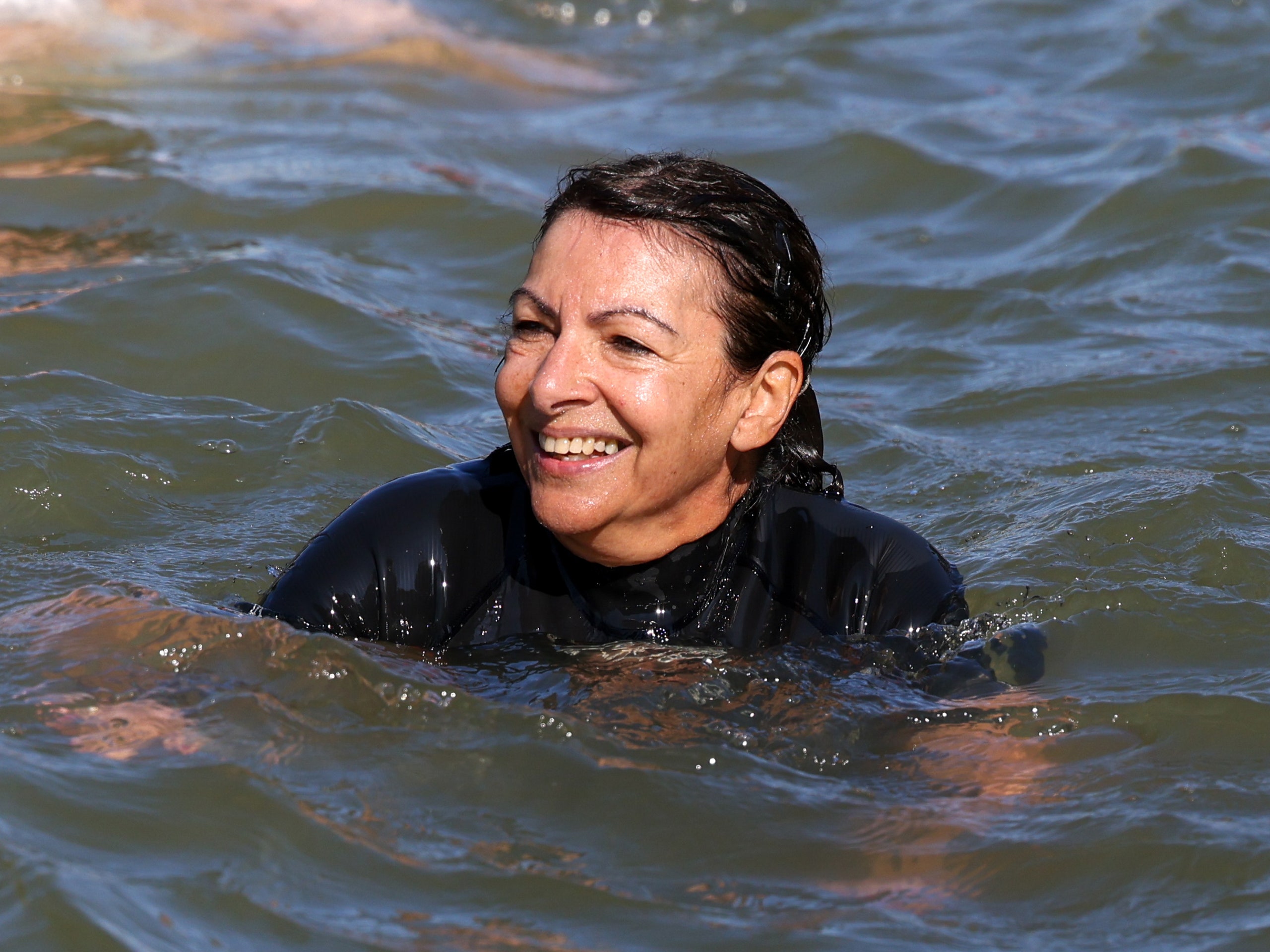The weather in Paris—sunny and warm, with a light breeze—could not have been more perfect for a swim. Until this morning, a dip in the Seine would have seemed unfathomable—but a little before 10 a.m., Anne Hidalgo, the mayor of Paris, made good on her pledge to take the plunge ahead of the Summer Olympics.
The much-anticipated event took place on a calmer stretch of the Seine between the Right Bank and the Île St. Louis, far from the sightseeing boats or barges that crawl up and down the river. Crowds along the embankments and the closest bridge, Pont Sully, gathered as though waiting for a fashion show. Aside from members of the press—representing outlets based all over the world, from Spain to Japan—people from various swim organizations had also been invited to participate. In their clingy maillots de bain, idling barefoot along the paved stones, they could have been transported straight from the Côte d’Azur.
Accompanied by Tony Estanguet, head of the organizing committee for the 2024 Paris Games, and Marc Guillaume, prefect of the Île-de-France region, Hidalgo arrived at an arrangement of pontoons, seemingly aware that all eyes would be on her every move. Wearing a short-sleeve wetsuit, she held onto her goggles; lowered herself in; treaded about, while the others entered; and began a confident freestyle—head submerged—that betrayed zero apprehension. A few minutes later, everyone reached the nearby platform but appeared content to float around a little longer.
Instagram content
This content can also be viewed on the site it originates from.
So how was the water? “Merveilleuse,” Hidalgo declared, using the French word for marvelous, as her eyes lit up and her smile widened. She was speaking to a throng of media, hair damp and still in her wetsuit, but now covered with an official Olympic warm-up jacket. “It was very mild, quite clear. It was fresh but not at all cold. It was really great, magnifique. We didn’t want to get out.”
If today proved that Hidalgo is a good sport and a mayor of her word, it also represented the achievement of an extraordinarily ambitious project years in the making. In fact, it has been illegal to swim in the Seine since 1923; in 1990, a promise by then mayor Jacques Chirac that the river would be safe for swimming within three years’ time went unfulfilled.
Hidalgo noted that today’s event was a kind of tribute to Chirac. “Sincerely, I think he really wanted to swim in the Seine,” she said. “Sometimes it takes a little while, but today we have done it.”
It required a monumental investment: The number most often cited is 1.4 billion euros (upward of $1.5 billion), mainly to improve the city’s sewer system, which becomes inundated when there are storms. (A gigantic new reservoir near the Austerlitz train station on the Right Bank can now store and treat much of this water before reintroducing it to the Seine.) Elsewhere, according to reporting by The New York Times, the project involved replacing the pipes of 20,000 homeowners, house by house.
Hosting the Olympics for the first time since 1924 proved the ultimate incentive, Hidalgo insisted: The idea was for certain aquatic sports—namely, the triathlon and distance-swimming events—to use the river as a venue. “If there weren’t the Games, we wouldn’t have arrived at this moment,” she said. “The Games were an accelerator that directed all our energies towards an objective with a deadline, and the deadline is, of course, July 26th.”
Still, a sense of uncertainty was ever present. An initial swim date of June 23 had to be rescheduled due to the high levels of E. coli and enterococci fecal bacteria in the Seine linked to municipal waste. Also, whether as a gross-out joke or a real call to action, the hashtag #JechiedanslaSeinele23juin (basically, a protest by poop) began circulating online as a way for those who oppose Hidalgo to spoil her plan.
Over the last month, news coverage remained skeptical, noting that there was ostensibly no ideal plan B for the relevant Olympic water competitions other than adjusting their dates. But as the weather gradually improved, sanitation authorities began adding a safe amount of performic acid, an organic compound, to the Seine to reduce the bacteria. Finally, the levels were trending in the right direction. And then, over the weekend, the minister of sports, Amélie Oudéa-Castera, took a dip of sorts, her awkwardness not entirely convincing.
Today, however, felt as official as it gets. In 2021, Hidalgo’s son Arthur Germain, who is an extreme adventurer, spent several weeks swimming the Seine to raise awareness about water pollution. The mayor, who joked that Germain had given her some pointers, noted that her own swim was “at once poetic and useful in terms of ecology, because if we can clean the Seine, we can clean the oceans.”
After Hidalgo made her exit (presumably to take a warm shower), some of the invited swimmers lingered on, simply enjoying the moment. Morgan and Gaël—who are accustomed to swimming in the Canal de l’Ourcq northeast of the city as part of a group called Les Ourcqs Polaires (a French play on polar bears)—said this was, indeed, a big deal. “Paris was born from the Seine centuries ago, so it was normal to bathe here,” said Morgan.
Beyond the Games, and thanks to Hidalgo’s determination, the hope is that some 20 points along the Seine and the Marne tributary will be designated for public recreation. Paris, city of the flaneur who walks, will soon stand out as the city of the baigneur who swims.
